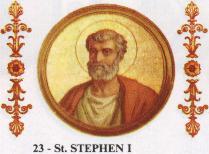Pope Stephen I
| Saint Stephen I | |
|---|---|

| |
| Birth name | Stephanus |
| Papacy began | ca. 12 May 254 |
| Papacy ended | 2 August 257 |
| Predecessor | Lucius I |
| Successor | Sixtus II |
| Born | ??? Rome, Italy |
| Died | August 2 257 Rome, Italy |
| Other popes named Stephen | |
| Styles of Pope Stephen I | |

| |
| Reference style | His Holiness |
| Spoken style | Your Holiness |
| Religious style | Holy Father |
| Posthumous style | Saint |
Pope Saint Stephen I served as Bishop of Rome from 12 May, 254 to 2 August, 257.
Of Roman birth but of Greek ancestry, he became bishop of Rome in 254, having served as archdeacon of Pope Lucius I, who appointed Stephen his successor.
At the time, internal disputes racking the Church were as much a threat as the external persecutions: following the Decian persecution of 250-251, there was disagreement about how to treat those who had lapsed from the faith, and Stephen was urged by Faustinus, Bishop of Lyon, to take action against Marcian, Bishop of Arles, who denied penance and communion to the lapsed who repented, the position called Novatianism, after Novatian, later declared a heretic, who held for the strictest approach.
This led to controversy over whether to accept as a valid sacrament baptism by splinter Christian groups. Stephen held that converts from such groups did not need rebaptism, while Cyprian and certain bishops of the Roman province of Africa held rebaptism necessary for admission to the Eucharist. Stephen's view eventually won broad acceptance.
He is also mentioned as having insisted on the restoration of the bishops of León and Astorga, who had been deposed for unfaithfulness during the persecution but afterwards had repented.
The "Depositio Episcoporum" of 354 speaks of Pope Stephen I as not a martyr.[1] Probably because of a conflation with his successor Pope Sixtus II, who was one of the first victims of Valerian's 258 persecution, it has been said that, as he was sitting on his pontifical throne in the catacombs, celebrating Mass for his congregation the emperor's men came and beheaded him on August 2, 257. As late as the 18th century, the chair was preserved, still stained with blood. Although Emperor Valerian's original persecution in 257 did not order summary execution of bishops, it did not exactly forbid them.
St Stephen I's feast day in the Roman Catholic Church is celebrated on August 2.[2] When the 1839 the new feast of St Alphonsus Mary de Liguori was assigned to 2 August, Saint Stephen I was mentioned only as a commemoration within the Mass of Saint Alphonsus. The revision of the calendar in 1969 removed the mention of Saint Stephen I from the General Roman Calendar, but, according to the General Instruction of the Roman Missal, the 2 August Mass may now everywhere be that of Saint Stephen I, unless in some locality an obligatory celebration is assigned to that day,[3] and some continue to use pre-1969 calendars that mention a commemoration of Saint Stephen I on that day.
Pope Saint Stephen I is the patron of Hvar.
| Roman Catholic Popes | ||
|---|---|---|
| Preceded by: Lucius I |
Bishop of Rome Pope 254–257 |
Succeeded by: Sixtus II |
Notes
- ↑ "Calendarium Romanum" (Libreria Editrice Vaticana, 1969), p. 133
- ↑ "Martyrologium Romanum" (Libreria Editrice Vaticana, 2001 ISBN 8820972107)
- ↑ "General Instruction of the Roman Missal" 355 c.
ReferencesISBN links support NWE through referral fees
External links
 Pope St. Stephen I in the 1913 Catholic Encyclopedia.
Pope St. Stephen I in the 1913 Catholic Encyclopedia.- His writings
| ||||||||||||||||
| |||||||||||||||||||||||||||||||||||||||||||||
| |||||||||||||||||||||||||||||||||||||||||
Credits
New World Encyclopedia writers and editors rewrote and completed the Wikipedia article in accordance with New World Encyclopedia standards. This article abides by terms of the Creative Commons CC-by-sa 3.0 License (CC-by-sa), which may be used and disseminated with proper attribution. Credit is due under the terms of this license that can reference both the New World Encyclopedia contributors and the selfless volunteer contributors of the Wikimedia Foundation. To cite this article click here for a list of acceptable citing formats.The history of earlier contributions by wikipedians is accessible to researchers here:
The history of this article since it was imported to New World Encyclopedia:
Note: Some restrictions may apply to use of individual images which are separately licensed.

